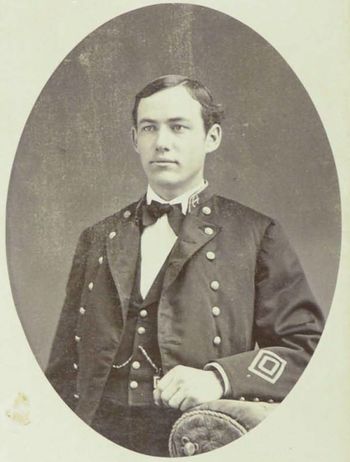FREEMAN H. CROSBY, LT, USN
Freeman Crosby '70
Freeman Hopkins Crosby was admitted to the Naval Academy from New York on July 30, 1886 at age 17 years 8 months.
Prior to the publication of the Lucky Bag in 1894, most portraits of officers and midshipmen of the Naval Academy were captured in yearly photo albums. The album for 1869 is available in the collections of the Naval Academy's Digital Collections.
Special thank you to historian Kathy Franz for identifying this resource and then extracting several dozen photographs for this site.

Prior to the publication of the Lucky Bag in 1894, most portraits of officers and midshipmen of the Naval Academy were captured in yearly photo albums. The album for 1869 is available in the collections of the Naval Academy's Digital Collections.
Special thank you to historian Kathy Franz for identifying this resource and then extracting several dozen photographs for this site.
Loss
Freeman was lost on August 18, 1894 when the whaleboat he was aboard capsized off the coast of Washington.
From Find A Grave (originally at NOAA; link no longer active):
On August 17, 1894, the Coast Survey Steamer McARTHUR anchored about 1 ½ miles offshore from Jo Creek, which lies about 17 miles north of Gray's Harbor, Washington. That afternoon Lieutenant Crosby, Commanding Officer, with nine men, landed through the surf and started to erect a hydrographic signal. The sea was smooth. On Saturday morning, there was a dense fog, and a long swell. At 7:20 am, the Commanding Officer with nine men in the whale boat left the ship to complete the erection of the signal. When outside the surf line, he directed the men to take all the precautions which are requisite for safety in going through the surf, such as removal of shoes and heavy clothing, casting off of trailing lines of the oars, and unshipping the rudder and substituting a steering oar. He cautioned them that if upset, they should get hold of life preservers or oars, dive under the breakers, and come up when necessary to breathe and make for the beach. They proceeded a short distance, when they were caught by a heavy breaker. The boat apparently broached, and was capsized by a second breaker. Five men succeeded in getting ashore, most of them in a dazed and exhausted condition. They immediately notified the white men and Indians along the beach, who took up the search for the others. The fog was very heavy, and visibility was not greater than 40 to 50 yards. No other landing could be made from the ship, so about 11 am, when the fog began to clear, the officer in charge ran in as close to the shore with the ship as was safe, but nothing could be done from the outside, so he proceeded inside Gray's Harbor and anchored near Damon's Point. C.P. Eaton, the Ensign in charge, secured a team and with two men drove up the beach to the scene of the disaster. Members of the crew and settlers patrolled the beach. On the way back to the ship, the team ran away while crossing a bridge over swampy land. The occupants were thrown out. The Ensign escaped with a sprained hand and leg and bruised head. One of the men had a bad hole made in front of his left leg, above the ankle, reaching to the bone. The bodies of Lieutenant Crosby and three of the men were washed ashore at various dates, that of Lieutenant Crosby six week after the accident.
From The Orlean Democrat on August 28, 1894:
A dispatch from Astoria, Oregon gives a graphic description by an eye witness of the terrible accident in which Lieut. Crosby, a former Jamestown boy, in which city he has many relatives, lost hislife. The story istold by W. M. Kenney, who was a passenger on the coast survey steamer McArthur, and was in the whaleboat when Lieut. Freeman H. Crosby and four of the crew were drowned. Mr. Kinney saya that the McArthur was anchored off Joe Creek, three-quarters of a mile from shore and fifteen miles north of the entrance to Gray's Harbor, on the Washington coast. The men had been ashore at this point Friday, and had experienced no difficulty.
"Saturday morning Lieut. Crosby, the quartermaster, eight of the crew, and Mr. Kenney, as a passenger, started for the shore to put up signals.
"We were in a small whaleboat as we left the ship," said Mr. Kenney. "I remarked to Lieut. Crosby that! did not like the looks of the breakers. He threw me a life preserver, and laughingly remarked: 'You better put that on.' I did. After we struck the first breaker a large swell hit the boat and lifted it completely out of the water, throwing me several feet to the rear and outside of the breakers. I immediately struck out for the ship, and was picked up by the small dinghy sent to meet me.
"As soon as I got into the dinghy I looked back and saw an immense breaker strike the whaleboat, lift it about ten feet into the air, and turn it completely over, burying the men underneath. The first one to appear was Lieut. Crosby, who made a gallant effort to reach the whaleboat, which was floating a short distance away. He was unable to do so and soon sank from sight. Men from the steamer made several attempts in the dinghy to reach their struggling comrades, but were unable to get to them on account of the heavy breakers. Five of the men managed to get hold of life preservers, of which there were six in the boat, and floated ashore. The remaining four went down with their commander, and in plain sight of their comrades, who were powerless to aid them.
"One man, Alexander Smith, just before he sank, waved his hand and shouted: 'Goodbye, boys, I am going.' The others kept calling for help until overpowered by the waves. They seemed to give up all hope, and, waving a last farewell, were seen no more."
Other Information
From researcher Kathy Franz:
Freeman died with four others on a whaleboat from the coast survey steamer McArthur on August 18, 1894. It capsized while making a landing through the rough surf at Jo creek, 15 miles north of Grays Harbor, Washington. The other men were John Fryer, Jens Gudmundsen, William Nehm and Alexander Smith. The group was to land and erect a hydrographic signal station. They had come into the shore daily without any mishap. Two breakers hit the whaleboat, the last throwing it ten feet high and turning the boat over. Freeman was last seen swimming for the whaleboat, but he sank and drowned. Mr. W. M. Kenney was thrown off when the first breaker hit and survived to give the account. He didn’t like the breakers, and Freeman had laughed and tossed him a life preserver to put on. Kenney said that they watched as Alexander Smith waved and said his last words: “Good-bye boys, I am going.”
Freeman was survived by his wife Julia Halsey, whom he had married on December 18, 1884, and their children Halsey, born in 1887, and George, born in 1892. When Freeman died, his family was living in Ocosta, Washington. They moved to Binghamton, New York, where she received a widow’s pension of $25/month. In 1897, it was raised to $35/month with $2/month extra per child until they reached the age of 16. Julia died on October 5, 1935.
Born in Poland, New York, Freeman lived with his father Elikman, mother Angelina, brother Walter, and sisters Ellen, Kate, Emma, Anna and Mabel. Additionally, by his father’s first wife, his brothers were Alonzo, Henry, and Erastus, and his sister was Cornelia, a schoolteacher. By 1880, the year his father died, the family lived in Jamestown, New York.
The family was friends with the family of Albert Sprague, Class of 1866, and they lived two miles apart. His daughter Katherine remembered Freeman often waving hello on his way home. She wanted to write a biography of Freeman for the Chautauqua County Historical Society. When Freeman came back from the Greely rescue in 1884, she remembered that a dinner was held in his honor in Jamestown, and he spoke with the high school students. Freeman was executive officer of the Bear, one of four vessels in the Greely rescuing expedition. Known as the Lady Franklin Bay Expedition 1881-1884, it was led by Lieutenant Adolphus Greely. Of the original 25 men, only 7 survived the expedition to the Arctic.
Freeman was commanding officer of McArthur (1874) (which was not a navy ship but owned by the United States Coast and Geodetic Survey).
Photographs
Career
From the Naval History and Heritage Command:
Midshipman, 30 July, 1866. Graduated 7 June, 1870. Ensign, 13 July, 1871. Master, 8 November, 1874. Lieutenant, 30 August, 1881. Drowned 18 August, 1894.
The "Register of Commissioned and Warrant Officers of the United States Navy and Marine Corps" was published annually from 1815 through at least the 1970s; it provided rank, command or station, and occasionally billet until the beginning of World War II when command/station was no longer included. Scanned copies were reviewed and data entered from the mid-1840s through 1922, when more-frequent Navy Directories were available.
The Navy Directory was a publication that provided information on the command, billet, and rank of every active and retired naval officer. Single editions have been found online from January 1915 and March 1918, and then from three to six editions per year from 1923 through 1940; the final edition is from April 1941.
The entries in both series of documents are sometimes cryptic and confusing. They are often inconsistent, even within an edition, with the name of commands; this is especially true for aviation squadrons in the 1920s and early 1930s.
Alumni listed at the same command may or may not have had significant interactions; they could have shared a stateroom or workspace, stood many hours of watch together… or, especially at the larger commands, they might not have known each other at all. The information provides the opportunity to draw connections that are otherwise invisible, though, and gives a fuller view of the professional experiences of these alumni in Memorial Hall.
January 1871
January 1872
January 1873
January 1874
January 1875
January 1876
July 1877
July 1878
July 1881
January 1882
January 1883
January 1884
January 1885
January 1886
February 1887
January 1888
October 1888
January 1889
January 1890
January 1891
January 1892
January 1893
July 1894
Memorial Hall Error
Freeman is not included with his classmates in Memorial Hall. This omission was discovered by researcher Kathy Franz.
Charles is one of 5 members of the Class of 1870 on Virtual Memorial Hall.

The "category" links below lead to lists of related Honorees; use them to explore further the service and sacrifice of alumni in Memorial Hall.

